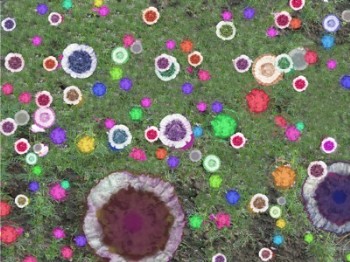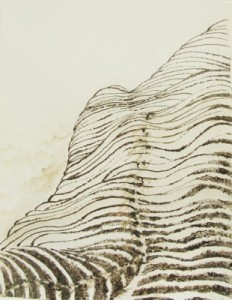Visual Arts Review: The Contemplative Art of Sue Yang — Where the Digital and the Organic Meet
Sue Yang’s eclectic solo exhibition explores the intersections of her multicultural identity through digital and organic art—each medium represents a different facet of the artist’s contemplative selfhood.
Sue Yang Solo Exhibition. At the Greater Boston Buddhist Cultural Center, Cambridge, MA, through June 18.
By Yumi Araki
Friends, students, and art aficionados of Chinese artist Sue Yang, recent winner of the 2011 SMFA Boston Traveling Fellowship Awards (and School of the Fine Arts faculty member, where she teaches classic Chinese brush painting, calligraphy, and computer application in visual art), gathered at the opening of her solo show. Yang is a charismatic hostess who cheerfully ushers guests to treats and tea arranged in the entrance of the bookstore.
Set in various rooms of the Buddhist Center, Yang’s eclectic solo exhibition explores the intersections of her multicultural identity through digital and organic art. Each medium represents a different facet of the artist’s selfhood, an exploration of Buddhist appreciations of nature and the organic that requires viewers to look long and think deep.
Festoons of what appear to be vibrant, blooming flowers are the dominant motifs of Yang’s Coffee Filter collection, which is displayed in the Center’s café area. Yang tells me that she photographs used coffee filters and renders them digitally through the use of software such as Photoshop. In Enjoying Too (archival inkjet, 2010), the artist combines the abstract and the concrete—colorful filters fill the paper and overwhelm a single mug at the center.
In Gardening (archival inkjet, 2010), Yang overlays her signature, blooming coffee filters atop a photograph of green grass, producing a rainbow of flowers in a field. There’s a playful whimsicality about the piece, but there’s also a lack of refinement, an ambiguity of intention and articulation in the composition. The piece tiptoes between garish pop art and absurdist impressionism.
But Yang argues that the inspiration behind her Coffee Filter collection springs from intense observation. In her artist statement, she describes the coffee filters as metaphors for the subconscious and conscious mind: “A discerning and contemplative mind filters out the negative allowing gratitude and joy to flow freely.” The joy is expressed through the colorized coffee filters, which gave them life, and the backdrops of many of the pieces are carefully chosen images from nature. The intention is admirable, and the organic harmony of recycled coffee filters against grass or a purple sunset is compelling. But knowledge of the artist’s intention is a necessary component for understanding the collection’s demanding aesthetic.
The contemplative muscle of Yang’s display in the adjacent tearoom, however, is apparent from the get-go. She uses coffee grinds to represent her Western identity and tea leaves to signify her traditional Chinese background. Real tea leaves and coffee grinds adorn canvases to create mountainous landscapes, reminiscent of the Japanese brushstroke art of sumié. Yang tells me that the tea leaves, like her coffee grinds, are ones she actually consumed and handpicked for her Tea/Coffee series. She incorporates different shapes and sizes because each leaf is unique, like people.
In Mountain Path (2011), Yang’s trees stand in succession across a topographic terrain created by bold, vertical lines filled with coffee grinds. Each tree casts two different shadows: a dark shadow reflects below the tea leaf, and a light one reflects above. Yang cleverly incorporates nature’s changes on the canvas: she painted each leaf’s shadow as the sun changed its course over the day. “They [the shadows] changed over time, so instead of creating different pieces to show this transformation, I put all the shadows in the same piece.” In this piece Yang’s creative thought is translated effectively onto the canvas, while her intention of reusing organic materials for art also adeptly reflects the overall message of the collection.
Yang’s last three two collections, on display in the Buddhist Center’s chanting room, hover somewhere between the Coffee Filter and Tea/Coffee series in scope and aesthetic effectiveness. Lotus with Marbles and The Pearl are collections of photographic collages printed on shiny, acetate boards. In Harmony (2006) from Lotus with Marbles, golden carp swim serenely around a bed of floating lotus pads and fluttering monarch butterflies. Yang explains that the title describes the unity attained by bringing the carp (below the water), the lotus pods (hovering just on top of the water), and the butterflies (fluttering above the water) into one piece. Unfortunately, the acetate board robs the piece of the multidimensional contours and shapes that would have accentuated the power of this beautifully lit work.

HARMONY (2006): Golden carp swim serenely around a bed of floating lotus pads and fluttering monarch butterflies. Courtesy of the artist
Precious Spring (2009) from The Pearl series is a close-up photograph of the mouth of a shimmering, amethyst, pearl shell. The pearl beads glimmer in soft, natural light as faint brushstrokes of Chinese characters blend into the shell’s lining. Yang writes that this collection pays tribute to the Chinese belief that pearls are not only valued for their aesthetic, but also for the pain that produces their beauty. While some of Yang’s complex intention comes across, especially in pieces where the pearl bulbs are positioned as the focal points, many of the photos lose their intensity because of the artificial glare from the acetate.
The only piece that manages to thrive despite the shiny acetate material is Flying Too (2006) from the Butterfly collection. But even this fine piece—a herd of butterflies soaring across a pink, evening sky—comes across as commercialized because of the glossy board.
Still, despite the unfortunate selection of baseboard materials, Yang’s exhibition proffers a fascinating, meditative exploration of the artist’s cultural experience through a fusion of Eastern and Western art.



more images! one per body of work, please
I loved these paintings when Sue Yang exhibited them in Cambridge at the Greater Boston Buddhist Cultural Center on Mass Ave.